| Srl | Item |
| 1 |
ID:
121675
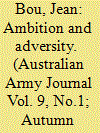

|
|
|
|
|
| Publication |
2012.
|
| Summary/Abstract |
Between its inception in 1901 and the beginning of the First World War in 1914, the Australian
Army (or the Commonwealth Military Forces as they were then known) underwent two
periods of extensive reform aimed at creating a modern effective force out of what had been
inherited from the colonial governments. In both instances the reforms were ambitious
and bold, but they were also severely troubled by the limitations imposed by government,
insufficient resources and a fundamental problem of creating an army from an almost entirely
part-time soldiery. This article was originally presented as a paper at the Chief of Army
Military History Conference in September 2011. It was first published in the proceedings of
that conference and is reproduced courtesy of the Australian Army History Unit.
|
|
|
|
|
|
|
|
|
|
|
|
|
|
|
|
| 2 |
ID:
121676
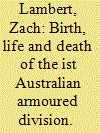

|
|
|
|
|
| Publication |
2012.
|
| Summary/Abstract |
This article examines the history of the formation of the Australian 1st Armoured Division for
use in both the Middle East and the defence of the Australian mainland during the Second World
War, from the intellectual and policy developments leading to approval by the War Cabinet to
the equipment, manning and training issues experienced in trying to raise a formation in a
short period. It also addresses the purpose of the formation given the circumstance of the time,
and the creation and continuation of the armoured tradition in the Australian Army. It finally
looks at the way the unit was disbanded and the follow-on effects to Australian armour, briefly
addressing the impact of the armoured vehicle in Australia's primary operating environment.
|
|
|
|
|
|
|
|
|
|
|
|
|
|
|
|
| 3 |
ID:
121670
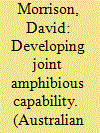

|
|
|
|
|
| Publication |
2012.
|
| Summary/Abstract |
The following is the text of an address given by the Chief of Army, Lieutenant General
David Morrison, to the Royal Australian Navy's Sea Power Conference in Sydney on 31
January 2012. Lieutenant General Morrison stated that the introduction into the Australian
Defence Force of new amphibious capability is anything but routine. The Landing Helicopter
Docks cannot be thought of as merely a transport capability. Rather they are an integral part
of a combat system with unique, and unprecedented, command and control and sustainment challenges. The acquisition of the Landing Helicopter Docks represents not only far
greater technical complexity in the operating systems than the Australian Defence Force has
previously experienced, but will introduce a far greater complexity into the joint training,
scheduling and integration across and between services. All parts of Defence activity are
going to be affected and will need to adjust. The Army is up for this challenge. The future
generations of Army officers will be trained and exposed to amphibious operations from the
outset of their careers, as a central pillar to how we fight. This will require an agile and joint
mindset that we cannot claim to possess across the entire force at present.
|
|
|
|
|
|
|
|
|
|
|
|
|
|
|
|
| 4 |
ID:
121674
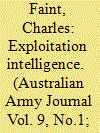

|
|
|
|
|
| Publication |
2012.
|
| Summary/Abstract |
Lessons learned by the United States in the global war on terror and in overseas contingency
operations underscore the value of intelligence information gleaned from the exploitation of
captured enemy personnel, equipment, and materiel. A key element of successful exploitation is accurately categorising information by intelligence discipline in order to apply the
correct resources towards the exploitation effort and maximize exploitation potential. In
light of these revelations, it is time to review the existing intelligence disciplines to determine
whether a new intelligence discipline- exploitation intelligence or 'EXINT'- should be added
to the disciplines currently in existence.
|
|
|
|
|
|
|
|
|
|
|
|
|
|
|
|
| 5 |
ID:
121672
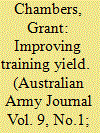

|
|
|
|
|
| Publication |
2012.
|
| Summary/Abstract |
Field training time in the Australian Army is a precious commodity. It is also unlikely to
increase in the near future. Fighting echelon units must examine ways of improving their
training yield if they are to improve their combat effectiveness. This paper examines three
ways that fighting echelon units can improve their training yield. First, by using regimental
training to turn their junior leaders into better collective trainers. Second, by using early
evaluation of whole-task training to improve training efficiency. Third, by increasing the
objectivity of training evaluation. Cognisant of the resource constraints facing units today,
the paper aims to offer pragmatic options that do not simply demand doing more with less.
Where options requiring greater effort are detailed, the costs are made clear, but so are
the benefits.
|
|
|
|
|
|
|
|
|
|
|
|
|
|
|
|
| 6 |
ID:
121671
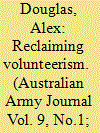

|
|
|
|
|
| Publication |
2012.
|
| Summary/Abstract |
The focus of the Army Reserve has shifted from supplying deployable units for large-scale
conventional warfare to providing individuals and small groups to support the Army's current
operations. The requirement for soldiers to be easily integrated into Regular units has caused
us to increasingly train, treat and manage reservists identically to their full-time counterparts.
This is ineffective because it fails to accept the real and important differences between Regular
and Reserve service. Reservists should actually be seen as sharing more characteristics with
volunteers than part-time employees. The strategies used and many of the lessons learnt in the
voluntary sector could be applied to increase the Reserve's capability and performance.
|
|
|
|
|
|
|
|
|
|
|
|
|
|
|
|
| 7 |
ID:
121689


|
|
|
|
|
| Publication |
2012.
|
| Summary/Abstract |
In a little known episode of history, the Imperial Japanese Navy (IJN) seized Christmas
Island unopposed on 31 March 1942. Pre-landing air and naval bombardments led the tiny
garrison to surrender, but also damaged key facilities, frustrating Japanese efforts to quickly
remove the valuable phosphate ore. When Japanese engineers determined the island was not
suitable for the construction of an airfield, the occupying force was left solely reliant upon
sea lanes of communication, vulnerable to submarine interdiction. A late-1943 submarine
attack led to the IJN's complete withdrawal from its Christmas Island outpost.
|
|
|
|
|
|
|
|
|
|
|
|
|
|
|
|
| 8 |
ID:
121673
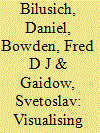

|
|
|
|
|
| Publication |
2012.
|
| Summary/Abstract |
Adaptive Campaigning- Future Land Operating Concept describes the Australian land force's
response to the challenges of future warfare. It discusses the need for Army to perform
successfully over various lines of operation and to maintain an adaptive approach in order to
achieve its objectives. However, the novel nature of this approach poses some challenges in its
practical implementation. A visualisation technique known as influence diagrams is employed
to examine adaptive campaigning and help support its further development as a concept.
|
|
|
|
|
|
|
|
|
|
|
|
|
|
|
|